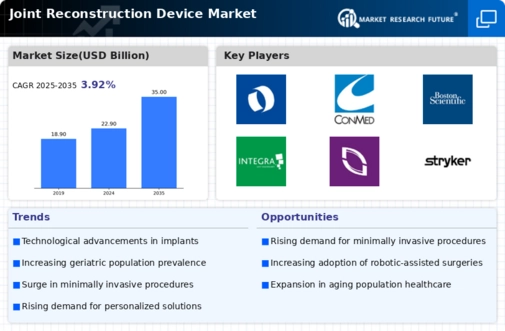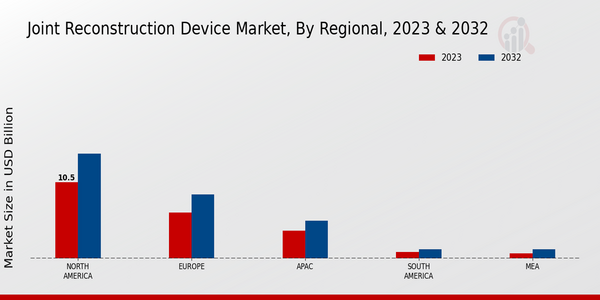Aging Population
The Global Joint Reconstruction Device Market Industry is experiencing growth driven by the increasing aging population worldwide. As individuals age, the prevalence of degenerative joint diseases, such as osteoarthritis, rises significantly. In 2024, the market is projected to reach 22.9 USD Billion, reflecting the urgent need for effective joint reconstruction solutions. By 2035, this figure is expected to grow to 35.0 USD Billion, indicating a robust demand for joint replacement surgeries. The aging demographic necessitates innovative devices that enhance mobility and improve quality of life, thereby propelling the market forward.
Increasing Sports Injuries
The rise in sports-related injuries is another critical factor driving the Global Joint Reconstruction Device Market Industry. As participation in sports and physical activities increases, so does the incidence of joint injuries, particularly among younger populations. This trend necessitates effective joint reconstruction solutions to address injuries such as ligament tears and cartilage damage. The demand for reconstructive surgeries is expected to surge, as athletes and active individuals seek to return to their pre-injury performance levels. Consequently, the market is poised for growth, as healthcare providers respond to the increasing need for specialized joint reconstruction devices.
Technological Advancements
Technological advancements in joint reconstruction devices are a pivotal driver of the Global Joint Reconstruction Device Market Industry. Innovations such as robotic-assisted surgeries, 3D printing, and minimally invasive techniques are transforming the landscape of joint reconstruction. These advancements not only improve surgical outcomes but also reduce recovery times for patients. As a result, healthcare providers are increasingly adopting these state-of-the-art technologies, which is reflected in the market's projected growth. The integration of smart technologies into devices may further enhance their functionality, appealing to a broader patient base and driving market expansion.
Market Trends and Projections
Rising Healthcare Expenditure
Rising healthcare expenditure globally is significantly influencing the Global Joint Reconstruction Device Market Industry. Governments and private sectors are investing heavily in healthcare infrastructure, leading to improved access to surgical procedures and advanced medical technologies. This trend is particularly evident in emerging economies, where increased spending on healthcare is facilitating the adoption of joint reconstruction devices. As healthcare budgets expand, more patients can afford joint replacement surgeries, contributing to the market's growth. The anticipated compound annual growth rate of 3.92% from 2025 to 2035 underscores the positive trajectory of healthcare investments in this sector.
Growing Awareness and Education
Growing awareness and education regarding joint health and available treatment options are fostering growth in the Global Joint Reconstruction Device Market Industry. Patients are becoming more informed about the benefits of joint reconstruction surgeries, leading to increased consultations with healthcare professionals. Educational campaigns and outreach programs are effectively disseminating information about joint diseases and the importance of timely intervention. This heightened awareness is likely to translate into higher demand for joint reconstruction procedures, as individuals seek to improve their mobility and quality of life. The market's expansion is thus supported by a more informed patient population.













